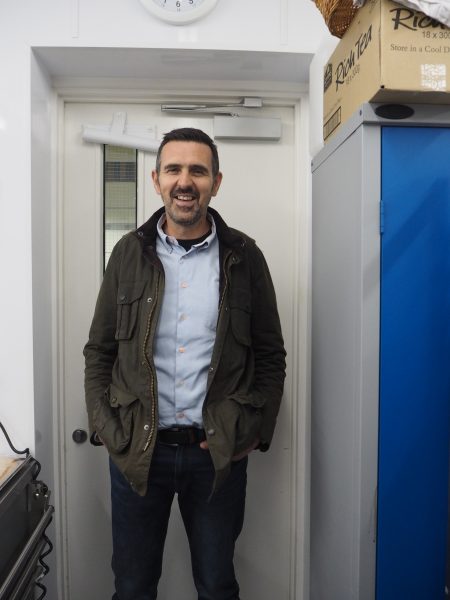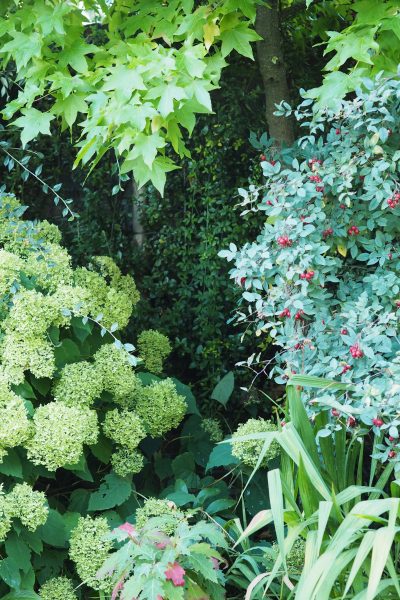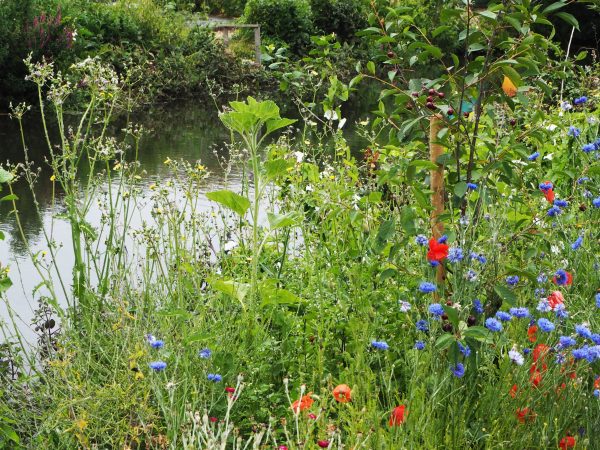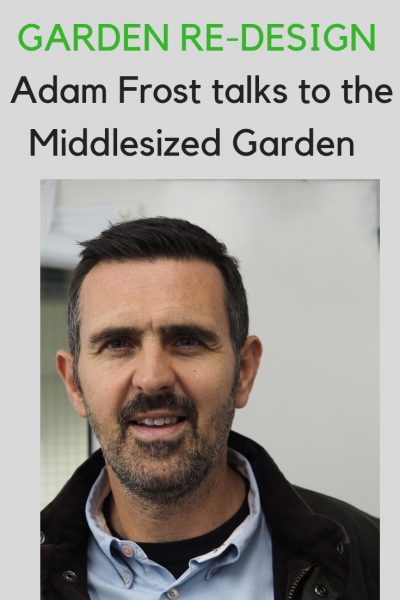Adam Frost’s top tips for your garden redesign
I asked garden designer Adam Frost about garden redesign. Especially if you have a middlesized garden and have recently moved in.
‘Recently’ in garden terms can be years, as you can live in a house for quite some time before deciding to ‘do’ the garden.
We met when he spoke at the Painters Forstal Garden Club. Before the talk started, we repaired to the hall’s mini-kitchen to discuss middle-sized gardens amid catering size packs of Rich Tea biscuits.
Adam has just published How to Create Your Garden – Ideas and Advice for Transforming Your Outdoor Space, so this is a subject he’s been thinking about alot! (links to Amazon are affiliate, see disclosure).

Surrounded by Rich Tea biscuits – it was a great treat to meet Adam to chat about garden redesign. He gave the Middlesized Garden some fab tips and he’s also a wonderful speaker (as you might expect). His advice is both inspiring and practical.
Adam Frost, of course, is a well known (and well loved) face on BBC Gardeners World. He has won seven Gold medals at the RHS Chelsea Flower Show. And recently he started the Adam Frost Garden School in his new home in Lincolnshire.
So I asked him what his advice was to anyone planning a garden redesign for their middle-sized space. ‘Middle-sized’ on this blog is under an acre, but the average garden size in Britain is currently around 50ft long, so that was what we were talking about.
Or watch the video…
If you prefer watching a video, this also has Adam’s tips:
Don’t do anything when planning a garden redesign!
‘Get to know your garden before you do anything,’ says Adam. He himself has recently moved into a new house and garden. Before doing his own garden redesign, he’s followed his own advice:
‘When we moved into our house, I walked the space every evening and every morning, so that I really understood it.’
You might think that a garden designer would prioritise creating a wonderful garden before anything else.
‘But it’s better to understand it first,’ he advises. ‘Find out where the sun comes up, and where it goes down. Where are you drawn to in the garden? Is there anywhere you don’t really like? Why is that? Have you got a good view? Or something you want to hide? Is privacy an issue?’
‘Give it a whole growing season before you make changes. Don’t be in a hurry to slash and burn. You may inadvertently take out something that could have been a godsend.’
If you’ve been in your house for some time before deciding to ‘get the garden sorted’, then you’ve already done that bit. But it’s probably worth writing it all down.
Forget your prejudices
‘Forget any gut reaction you have on things you don’t like.’
This certainly resonates with me. When we first moved in, we were determined to get rid of a large cypress ‘Leylandii’.
After all, no-one ever has a good word for a Leylandii. However we keep this one under control by pruning it every few years. It adds evergreen structure to the garden and blocks an ugly street lamp. If we’d ripped out – and we so nearly did – the glare on our terrace would have been close to unbearable.
And once you have removed a mature tree, it can take years before its replacement can properly fulfill its role.
‘For example,’ says Adam, ‘you might instinctively want to remove a hedge and have a fence, but you’d be taking out a massive wildlife habitat. It’s really worth thinking about, and being sure that you’re doing the right thing.’
Every garden has a micro-climate
Every garden, no matter how middle-sized, has a micro-climate. Adam quotes the experience he had of growing four rows of kale. The kale nearest the garden wall grew more than twice the size of the other kales, because it was close to the warmth of the wall. And each row of kale got smaller and smaller as it got further away from the warmth of the brick.
Equally, you may find some pockets of cold.
Frost on garden privacy
Adam quotes ‘noisy neighbours’ and privacy as issues you may want to address in your garden redesign. To counteract noisy neighbours, he suggests adding a water feature and creating a cosy, secluded spot. You won’t lose all the noise but there’ll more of a sense of privacy.
And when it comes to privacy from over-looking windows, he cautions against planting trees against the fence at the bottom of the garden. ‘It could take 10-15 years before a tree is big enough to block a sight-line,’ he says. ‘But you can achieve an intimate, private feeling by planting smaller trees or shrubs round the terrace where you sit.’
A garden needs layers
‘Good gardens have the right amount of layers,’ he says. He believes that a good garden in the UK ‘reflects an English woodland. A woodland naturally has four layers.’
‘First you have your mature trees – your oaks and beeches. Then there are the smaller, younger trees.’
After that you’ll see the equivalent of shrubs – in some woodland you’ll see rhododendrons or hawthorn, growing sideways to make the most of the light. Then there are ferns and bracken – the equivalent of the herbaceous border.
And finally you get the lowest level – the snowdrops, bluebells, anemones and more. This is your bulb layer.’
I can see what he means. Think about a garden you’ve seen that doesn’t have any mature trees – just shrubs and herbaceous plants. It doesn’t feel right, does it?
It’s all about the soil
When Adam started to speak to us all in the hall, he asked how many of us had tested our soil. Only about half a dozen hands went up. There were about 100 people in the room.
I’m sorry to confess that I was not one of those who had tested their soil. He explained that it was essential. When he moved into his own new garden, he tested the soil in dozens of places, and even though he thought he could tell what it was like just by what was growing there, he still had quite a few surprises.
Experts have been telling me to test my soil for years. so I went online to research best soil testing kits. Going by the number of reviews and stars on Amazon, and also by checking soil testing kit reviews, I bought three soil testing kits.
They are the Moon City 3-in-1 soil tester and The Soil Test Kit with the Soil PH Test Kit . I will report back on them soon.
Plan your foliage before your flowers
If you have a gap, Adam suggests you forget about the colour of the flowers. Think about the leaf shape. ‘Put a plant with a different leaf form in the gap.’
This is a fascinating exercise. I have an empty space in the middle of a border. It is so difficult to avoid thinking about flower colour – it’s almost like trying to write left-handed if you’re right-handed.
But I am repeating ‘different leaf shape’ over and over again as a mantra.

Leaf contrast – I absolutely love this combination, and with the exception of the Hydrangea ‘Annabelle’, it is all about foliage. It was, however, a lucky accident – I didn’t plan it that way.
Plant for wildlife
‘We’ve lost 97% of our wildflower meadows in the last 10 years,’ says Adam. If you’re planning a garden redesign, then design in the wildlife, because our gardens can help fill that gap. And planting for wildlife doesn’t have to mean having a wildflower meadow.

A patch of meadow planting at our local Stonebridge Pond Allotments.
There are two posts that may be helpful here: what makes a good wildlife garden and how to plant a mini-wildflower meadow.
Or if you prefer video – here is how to plant a mini wildflower meadow and more tips in a tour of the wildlife-friendly Abbey Physic garden in from bare earth to wildlife sanctuary.
Repeat shapes and colours
In the talk to the Painters Forstal Gardening Club, Adam showed us how important repetition is. He advised us against planting a clump of one thing followed by a clump of another.
Instead he showed us how effective it is to repeat several groups of plants along a border.
He also advises simplifying borders by repeating the same colours along it. While doing your garden redesign, think about how you plant, not just what you plant.
Think about what word fits your garden redesign
Adam suggests summing up your garden with a word. It could be ‘calm’ or ‘romantic’. ‘Then,’ he says, ‘assess something you want to buy against that word. Tell yourself that if it’s not ‘romantic’ or ‘calm’, then it’s not coming home.’
Finally…
‘Don’t chase the dream that it’s got to be perfect all summer,’ says Adam. ‘Enjoy the moments, find your own way, and don’t worry about what anyone else thinks.’
Adam’s talk to the Painter’s Forstal Gardening Club was enormously enjoyable and helpful, too. You can find out more about his garden design service, garden school and availability for talks on adamfrost.co.uk
Catch up with the BBC Gardeners World here.
And do join us on the Middlesized Garden every Sunday morning (leave your email in the box) or the Middlesized Garden YouTube channel every Saturday. Thank you!
Pin for reference
And if you’d like more of Adam’s excellent advice, his book How To Create Your Garden – Advice and Ideas for Transforming Your Outdoor Space is published by the RHS.

























Great post! I need to test the soil in my garden too. So how’s the soil tester you tested?
Nice one Adam !